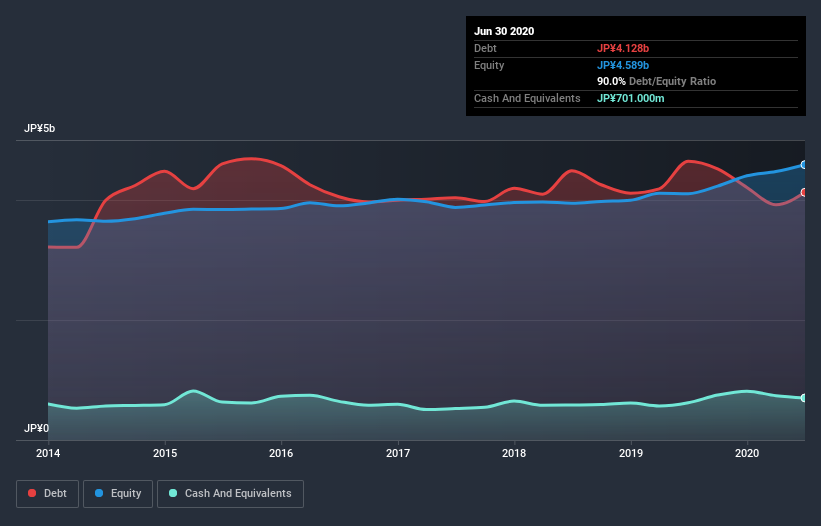Legendary fund manager Li Lu (who Charlie Munger backed) once said, ‘The biggest investment risk is not the volatility of prices, but whether you will suffer a permanent loss of capital.’ When we think about how risky a company is, we always like to look at its use of debt, since debt overload can lead to ruin. As with many other companies Nippon Pallet Pool Co., Ltd. (TYO:4690) makes use of debt. But should shareholders be worried about its use of debt?
When Is Debt A Problem?
Debt is a tool to help businesses grow, but if a business is incapable of paying off its lenders, then it exists at their mercy. In the worst case scenario, a company can go bankrupt if it cannot pay its creditors. However, a more usual (but still expensive) situation is where a company must dilute shareholders at a cheap share price simply to get debt under control. By replacing dilution, though, debt can be an extremely good tool for businesses that need capital to invest in growth at high rates of return. The first step when considering a company’s debt levels is to consider its cash and debt together.
See our latest analysis for Nippon Pallet Pool
What Is Nippon Pallet Pool’s Net Debt?
The image below, which you can click on for greater detail, shows that Nippon Pallet Pool had debt of JP¥4.13b at the end of June 2020, a reduction from JP¥4.65b over a year. However, it does have JP¥701.0m in cash offsetting this, leading to net debt of about JP¥3.43b.

A Look At Nippon Pallet Pool’s Liabilities
Zooming in on the latest balance sheet data, we can see that Nippon Pallet Pool had liabilities of JP¥3.16b due within 12 months and liabilities of JP¥2.60b due beyond that. Offsetting this, it had JP¥701.0m in cash and JP¥823.0m in receivables that were due within 12 months. So its liabilities total JP¥4.23b more than the combination of its cash and short-term receivables.
When you consider that this deficiency exceeds the company’s JP¥3.95b market capitalization, you might well be inclined to review the balance sheet intently. In the scenario where the company had to clean up its balance sheet quickly, it seems likely shareholders would suffer extensive dilution.
We use two main ratios to inform us about debt levels relative to earnings. The first is net debt divided by earnings before interest, tax, depreciation, and amortization (EBITDA), while the second is how many times its earnings before interest and tax (EBIT) covers its interest expense (or its interest cover, for short). The advantage of this approach is that we take into account both the absolute quantum of debt (with net debt to EBITDA) and the actual interest expenses associated with that debt (with its interest cover ratio).
Nippon Pallet Pool’s net debt is only 1.1 times its EBITDA. And its EBIT covers its interest expense a whopping 23.4 times over. So we’re pretty relaxed about its super-conservative use of debt. Better yet, Nippon Pallet Pool grew its EBIT by 145% last year, which is an impressive improvement. If maintained that growth will make the debt even more manageable in the years ahead. The balance sheet is clearly the area to focus on when you are analysing debt. But it is Nippon Pallet Pool’s earnings that will influence how the balance sheet holds up in the future. So when considering debt, it’s definitely worth looking at the earnings trend. Click here for an interactive snapshot.
Finally, while the tax-man may adore accounting profits, lenders only accept cold hard cash. So it’s worth checking how much of that EBIT is backed by free cash flow. Happily for any shareholders, Nippon Pallet Pool actually produced more free cash flow than EBIT over the last three years. There’s nothing better than incoming cash when it comes to staying in your lenders’ good graces.
Our View
Happily, Nippon Pallet Pool’s impressive interest cover implies it has the upper hand on its debt. But we must concede we find its level of total liabilities has the opposite effect. When we consider the range of factors above, it looks like Nippon Pallet Pool is pretty sensible with its use of debt. That means they are taking on a bit more risk, in the hope of boosting shareholder returns. When analysing debt levels, the balance sheet is the obvious place to start. But ultimately, every company can contain risks that exist outside of the balance sheet. Take risks, for example – Nippon Pallet Pool has 3 warning signs we think you should be aware of.
When all is said and done, sometimes its easier to focus on companies that don’t even need debt. Readers can access a list of growth stocks with zero net debt 100% free, right now.
Promoted
When trading Nippon Pallet Pool or any other investment, use the platform considered by many to be the Professional’s Gateway to the Worlds Market, Interactive Brokers. You get the lowest-cost* trading on stocks, options, futures, forex, bonds and funds worldwide from a single integrated account.
This article by Simply Wall St is general in nature. It does not constitute a recommendation to buy or sell any stock, and does not take account of your objectives, or your financial situation. We aim to bring you long-term focused analysis driven by fundamental data. Note that our analysis may not factor in the latest price-sensitive company announcements or qualitative material. Simply Wall St has no position in any stocks mentioned.
*Interactive Brokers Rated Lowest Cost Broker by StockBrokers.com Annual Online Review 2020
Have feedback on this article? Concerned about the content? Get in touch with us directly. Alternatively, email [email protected].


